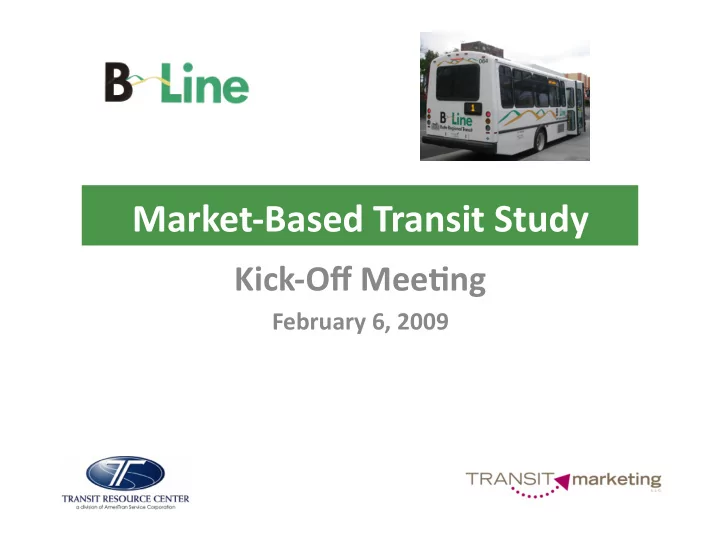

Market‐Based Transit Study Kick‐Off Mee6ng February 6, 2009
Overview Who We Are Study Objec4ves Key Challenges Our Approach Key Milestones
Who We Are
3 Key Study Objec4ves Iden4fy the transit market needs of exis4ng and poten4al riders and determine the most cost effec4ve rou4ng and scheduling that match market needs with available resources. Improve the efficiency and effec4veness of the fixed routes by improving produc4vity, addressing schedule adherence problems, and improving farebox recovery ra4os. Increase ridership, improve customer sa4sfac4on, and provide an accessible, convenient public transporta4on service.
Key Market Challenges
Changing Ridership Base 50% of riders have begun using B-Line since 2006
Students Are a Diverse Group 48% X 53% = 26% CSU Students in Sample
24/7 Economy and Transit Slightly more than half of the employed riders (53%) said they work on Saturdays, and 42% said they work on Sunday. Unfortunately, of those who work on weekends, more than two‐thirds (68%) said the bus does not run when they need it for work on the weekend. This is a service alloca4on conundrum because later evening and weekend service has lower produc4vity and drives down farebox recovery.
Addressing Exis4ng Rider Concerns Good Pretty good Not so good
Key Opera4onal Challenges All but 2 routes are behind schedule by at least 10 minutes or more each day, and 3 routes are behind schedule 30 minutes or more. Significant out‐of‐direc4on travel for some trips. Example: Weekday trip to Chico Mall from Paradise or Oroville. While some would say this is a good problem to have, there is significant overcrowding on some bus runs. Schedule 4metables need to be adjusted for more system reliability
Approach
5 Key Components Market research Gather and illustrate facts on exis4ng condi4ons Develop and evaluate four alterna4ves Extensive public outreach Recommend preferred alterna4ve
Market Research Exis4ng customers: 2008 onboard survey Poten4al customers: Market segmenta4on telephone survey of 600 Bu_e County residents E‐surveys of CSU‐Chico and Bu_e College students. Ra4onale: Heavy student ridership and students not reached by tradi4onal telephone survey due to ubiquitous cell phone usage
Market Research: Trade‐Off Analysis A. B‐Line buses operate every 30 minutes B. B‐Line buses operate every 45 minutes from 6:30 am to 8 pm from 5:30 am to 1 a.m. A. Buses run every 15 minutes during B. Buses run every 30 minutes morning and acernoon commute hours throughout the day. and 60 minutes the rest of the day A. Have large buses running every 30 B. Have small buses running every 60 minutes with bus stops on major streets minutes with more bus stops on only. neighborhood routes A. Walk 6 blocks from your home to the B. Call two hours in advance for a mini‐ bus stop for a bus that runs every 60 bus to pick you up at your house and take minutes you to your des4na4on
Illustrate Facts On Exis4ng Condi4ons
Public Par4cipa4on: Phase I 4 public open houses to gather ini4al input: Chico, Oroville, Paradise, Gridley Combined with invited and recruited stakeholders interviews prior to open houses
Evaluate and Develop Four Alterna4ves 5% decrease from exis4ng 67,000 annual service hours Exis4ng 67,000 annual service hours 5% increase above 67,000 annual service hours 10% increase above the current 67,000 annual hours 3-Day Design Summit
Public Par4cipa4on Phase II Two focus groups of exis4ng riders: students and non‐student to test alterna4ves Second round of open houses in Chico, Oroville, Paradise and Gridley to receive public comment on four alterna4ves
Evaluate and Recommend
Screen and Modify Alterna4ves Apply to Study Goals and Standards (reviewed later in agenda) Respond to public comments from the second round of four open house sessions. Prepare updated route network maps and summary tables of hours and frequencies for each alterna4ve Provide pros and cons of each alterna4ve Meet with Project Development Team to recommend preferred alterna4ve Present to BCAG Board for adop4on
Key Schedule Milestones First Round of Public Workshops: Week of March 23 rd Exis4ng Condi4ons Report: April 30 th Market Segmenta4on and E‐Surveys: April Market Segmenta4on Report: Early May Three Day Design Summit: Mid‐May Four Alterna4ves Working Paper: Mid‐July Focus Groups: August Second Round Public Workshops: early September Select Preferred Alterna4ve, Project Development Team: late September Drac Report: early November Final Report: January 2010
Recommend
More recommend